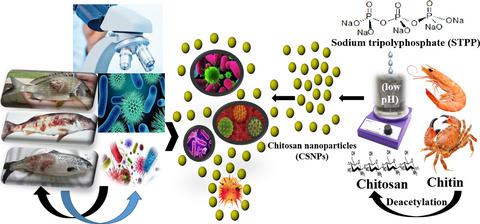当前位置:
X-MOL 学术
›
J. Fish Dis.
›
论文详情
Our official English website, www.x-mol.net, welcomes your feedback! (Note: you will need to create a separate account there.)
In vitro assessment of the antimicrobial efficacy of chitosan nanoparticles against major fish pathogens and their cytotoxicity to fish cell lines.
Journal of Fish Diseases ( IF 2.5 ) Pub Date : 2020-07-06 , DOI: 10.1111/jfd.13212 Fatma Ahmed 1, 2 , Faiza M Soliman 2 , Mohamed A Adly 2 , Hamdy A M Soliman 2 , Mansour El-Matbouli 1 , Mona Saleh 1
Journal of Fish Diseases ( IF 2.5 ) Pub Date : 2020-07-06 , DOI: 10.1111/jfd.13212 Fatma Ahmed 1, 2 , Faiza M Soliman 2 , Mohamed A Adly 2 , Hamdy A M Soliman 2 , Mansour El-Matbouli 1 , Mona Saleh 1
Affiliation

|
Nanotechnology is an emerging avenue employed in disease prevention and treatment. This study evaluated the antimicrobial efficacy of chitosan nanoparticles (CSNPs) against major bacterial and oomycete fish pathogens in comparison with chitosan suspension. Initially, the minimum inhibitory concentrations (MIC, MIC90) were determined and the per cent inhibition of bacterial growth was calculated. Subsequently, the minimum bactericidal concentrations (MBCs) were determined. The time‐dependent disruptions of CSNP‐treated pathogens were observed via transmission electron microscopy (TEM), and the effect of CSNPs on the viability of two fish cell lines was assessed. No antimicrobial effect was observed with chitosan, while CSNPs (105 nm) exhibited a dose‐dependent and species‐specific antimicrobial properties. They were bactericidal against seven bacterial isolates recording MBC values from 1 to 7 mg/ml, bacteriostatic against four further isolates recording MIC values from 0.125 to 5 mg/ml and fungistatic against oomycetes recording MIC90 values of 3 and 4 mg/ml. TEM micrographs showed the attachment of CSNPs to the pathogenic cell membranes disrupting their integrity. No significant cytotoxicity was observed using 1 mg/ml CSNPs, while low dose‐dependent cytotoxicity was elicited by the higher doses. Therefore, it is anticipated that CSNPs are able to compete and reduce using antibiotics in aquaculture.
中文翻译:

壳聚糖纳米粒子对主要鱼类病原体的抗微生物功效及其对鱼类细胞系的细胞毒性的体外评估。
纳米技术是在疾病预防和治疗中使用的新兴途径。这项研究与壳聚糖悬浮液相比,评估了壳聚糖纳米颗粒(CSNPs)对主要细菌和卵菌鱼类病原体的抗菌功效。最初,最低抑菌浓度(MIC,MIC 90确定)并计算细菌生长的抑制百分比。随后,确定最小杀菌浓度(MBC)。通过透射电子显微镜(TEM)观察到CSNP处理的病原体的时间依赖性破坏,并评估了CSNPs对两种鱼细胞系活力的影响。壳聚糖未观察到抗菌作用,而CSNPs(105 nm)表现出剂量依赖性和物种特异性的抗菌特性。它们对七个记录MBC值从1到7 mg / ml的细菌分离菌具有杀菌作用,对四个MIC值从0.125到5 mg / ml的分离菌具有抑菌作用,对记录MIC 90的卵菌具有抑菌作用。值为3和4 mg / ml。TEM显微照片显示CSNP附着在致病细胞膜上,破坏了它们的完整性。1 mg / ml CSNPs未观察到明显的细胞毒性,而较高剂量可引起低剂量依赖性细胞毒性。因此,可以预料,CSNPs能够竞争并减少在水产养殖中使用抗生素。
更新日期:2020-08-28
中文翻译:

壳聚糖纳米粒子对主要鱼类病原体的抗微生物功效及其对鱼类细胞系的细胞毒性的体外评估。
纳米技术是在疾病预防和治疗中使用的新兴途径。这项研究与壳聚糖悬浮液相比,评估了壳聚糖纳米颗粒(CSNPs)对主要细菌和卵菌鱼类病原体的抗菌功效。最初,最低抑菌浓度(MIC,MIC 90确定)并计算细菌生长的抑制百分比。随后,确定最小杀菌浓度(MBC)。通过透射电子显微镜(TEM)观察到CSNP处理的病原体的时间依赖性破坏,并评估了CSNPs对两种鱼细胞系活力的影响。壳聚糖未观察到抗菌作用,而CSNPs(105 nm)表现出剂量依赖性和物种特异性的抗菌特性。它们对七个记录MBC值从1到7 mg / ml的细菌分离菌具有杀菌作用,对四个MIC值从0.125到5 mg / ml的分离菌具有抑菌作用,对记录MIC 90的卵菌具有抑菌作用。值为3和4 mg / ml。TEM显微照片显示CSNP附着在致病细胞膜上,破坏了它们的完整性。1 mg / ml CSNPs未观察到明显的细胞毒性,而较高剂量可引起低剂量依赖性细胞毒性。因此,可以预料,CSNPs能够竞争并减少在水产养殖中使用抗生素。


























 京公网安备 11010802027423号
京公网安备 11010802027423号